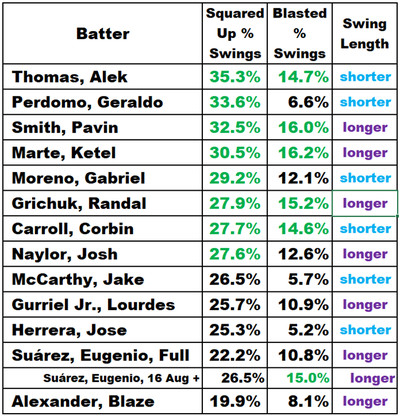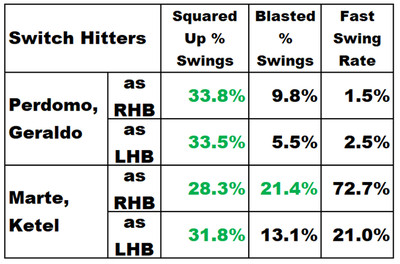
Starting in 2024, Baseball Savant added a bat tracking leaderboard. For this season’s Diamondbacks, let’s look at two of the many statistics on that leaderboard.
- Percentage of swings that are squared up. Squared up means the ball hit the bats sweet spot. That is determined by comparing exit velocity with bat speed and pitch speed.
- Percentage of swings that are blasted. Blasted means squared up with a fast swing (sweet spot on the bat moves at 75 MPH or faster.
For a broader perspective, please note that blasted balls are more common than barrelled balls. Whether a ball is barrelled depends on the combination of exit velocity and launch angle.
Demarcation lines. Subjectively determined, these lines separate the best batters from the others. The best batters had the following:
- Percentage of swings that were squared up: 27.6%.
- Percentage of swings that were blasts: 14.6%.
How well did Diamondbacks make contact?
Instead of looking at all Diamondbacks in 2024, let’s exclude batters who are no longer with the team, and exclude batters with less than 50 balls in play from competitive swings (Adrian Del Castillo and Jorge Barrosa). Adding Josh Naylor and recently re-signed Randal Grichuk, thirteen batters remain.
Before presenting a table, there are four notes.
- Alek Thomas. His 35.3% squared-up was the highest of this season’s Diamondbacks. This season, he has significant potential to increase his 66 OPS+.
- Ketel Marte. His 16.2% blasted edged ahead of Pavin Smith for the highest of this season’s Diamondbacks.
- Eduardo Suarez. An extra line in the table to shows Eduardo Suarez’s performance from 16 August through the end of the season. It was added because his batting improved late in the season. Despite his full season improvement (OPS+ improved from 103 to 115 and SLG improved from .391 to .469) compared to 2023, his full-season statistics fell below the demarcation lines for squared up batted balls and blasted batted balls.
- Swing Length. For batters who reached the demarcation line for blasts, Let’s consider their swing lengths (whether they were longer or shorter than the median swing length of 7.2 feet for twelve batters before Grichuk was re-signed).
The following table shows Diamondbacks batters for this season.

2024 Season. Data from Baseball Savant.
It’s amazing that two of the six batters with superior blast percentages (Carroll and Thomas) had shorter swings. That is strong evidence that what works well is different for each batter.
Three batters fell below the blasts demarcation line but reached the squared-up demarcation line (Perdomo, Moreno, and Naylor). Perdomo and Moreno were solid batters. Naylor was more than a solid batter. He was a power batter based on his season SLG of .456. I don’t know why he fell short of the demarcation line for blasts (12.6% vs 14.6%). It will be interesting to look at him this season.
Having less than 10% fast swings explains three of the four batters who did not reach either demarcation line. Perhaps increasing their bat speed would improve their percentages of squared-up and blasted balls. However, it is unclear if that would negatively impact their contact rate, thereby making their batting worse.
The batter who is my biggest puzzle is Blaze Alexander. With 30.4% fast swings, he nevertheless fell significantly short of the two demarcation lines. Clearly, bat speed isn’t the entire answer to him improving his batting.
Two switch hitters.
Two Diamondbacks were switch hitters with enough PAs to make interesting conclusions (Ketel Marte and Geraldo Perdomo).
Geraldo Perdomo had a higher percentage of pitches that he blasted as a right-handed batter (9.8% vs 5.5%). However, he fell short of the demarcation line for blasts.
Ketel Marte had a higher percentage of pitches that he blasted as a right-handed batter (21.4% vs 13.1%). Perhaps the reason was that his fast swing rate for competitive swings was very much higher (72.7% vs 21.0%). As a left-handed batter, Marte may have slowed his swing to better hit the sweet spot of the bat. That idea is supported by his higher squared up percentage as a left handed batter (31.8% vs 28.3%) .
For details, see the following table:

2024 Season. Data from Baseball Savant,
Summary.
Baseball Savant’s bat tracking leaderboard provides:
- Percentage of swings that are squared up. Squared up means the ball hit the bats sweet spot. That is determined by comparing exit velocity with bat speed and pitch speed.
- Percentage of swings that are blasted. Blasted means squared up with a fast swing (sweet spot on the bat moves at 75 MPH or faster.
Alek Thomas’s 35.3% squared-up was the highest of this season’s Diamondbacks. This season, he has significant potential to increase his 66 OPS+.
Ketel Marte’s 16.2% blasted edged ahead of Pavin Smith for the highest of this season’s Diamondbacks.
Of the six batters with superior blast percentages, two had short swings and four had long swings. That is strong evidence that what works well is different for each batter.
Two switch hitters (Perdomo and Marte) had a higher percentage blasts as right-handed batters.
As a left-handed batter, Marte may have slowed his swing to better hit the sweet spot of the bat. Supporting that idea are that as a left-handed batter, he had a lower fast-swing-rate, and he had a higher squared-up percentage.
